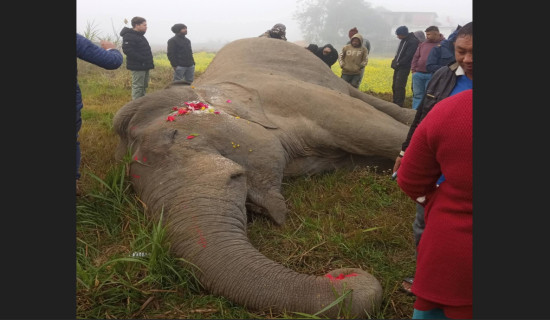- Tuesday, 6 January 2026
New Wheels In Politics
Nepal looks set to go through a process of leadership transition. This process is not in deed the case impacting a single or a maze of so-called leftist or the rightist political parties. This phenomenon has more or less occupied the entire political milieu in Nepal. The dominance of elder generation in party leadership (better termed as gerontocracy) has ruled the political roost incessantly and dictated its course of action for several decades. However, it is gradually facing the challenge of retaining its relevance, acceptability and legitimacy in the evolving political context of Nepal. The challenges to the senior generation of leadership have become more articulate and vociferous in noticeable terms after the local elections conducted during the previous month.
Clear expression
The people's frustration and discontent with the political parties and their leadership had been expressed through the vote. This has found clear expression as the independent candidates like Balendra Shah from Kathmandu, Gopi Hamal from Dhangadhi, Manoj Sah from Janakpurdham, Harka Rai from Dharan triumphed the poll. According to the report, over 35 candidates have won the top executive posts for the rural municipalities and municipalities in this year’s local election. This is significantly higher than the tally recorded in the previous local election held in 2017. The victory of Balendra Shah as mayor of the capital city has been read and construed, among others, as the indicator of growing aversion to and disenchantment of the voters especially in the urban areas with the conventional modus operandi of politics executed by self-centered political leaders in the country.
The success of Balendra in the polls has worked as a catalyst and thus motivated and inspired the new generation of youths in the capital city to join in the electoral politics to challenge the established order of the party leadership. Mention in this context can be made about the move of the popular TV programme host Rabi Lamichhane who has launched a new political outfit called Nepal Swatantra Party. Some say this surge of new politics cannot be dismissed as meaningless and vain political prank even as some political commentators simply quip that politics is easier said than done.
Anyway, the new party has already been registered at the Election Commission as a legal entity which has already vowed to contest the upcoming provincial assembly and federal parliament elections using its own symbol. The new political outfit coordinated by Lamichhane forges together a new set of lesser known youth aspirants who have chosen themselves to initiate and baptise into politics and use their agency to defy conventional order of party leadership.
It is not now only that the experimentation with new political group has been tried out. Almost seven years ago, Dr. Babu Ram Bhattarai who had masterminded the 10-year-long Maoist insurgency and also headed the country's executive government for almost a year had started a campaign towards building a renovated variant of alternative politics immediately after the promulgation of the new federal constitution in 2015. Dr. Bhattarai had branded his party as Naya Shakti Party targeting to supersede and dislodge the existing conventional political ragtags - NC, UML and CPN-Maoist – articulating the narrative that the country needs a new party to give leadership in the changed epoch of the twenty first century. Dr. Bhattarai was able to create a wave and many people tired of the old order politics rallied behind him spontaneously. KP Sharma Oli, the then prime minister, had attended the rally organised by Dr. Bhattarai's party where he had prophesised that the party would be able to dislodge all the others except his own UML.
Dr. Bhattarai had plunged into the theatrics of politics as the gallant critic of the Maoist movement that he had led and nurtured contending that its agenda no longer holds sense and logic in the changed political epoch. Dr. Bhattarai started Naya Shakti Party as an alternative political platform weaving a convincing narrative to challenge the corrupt political practices and values through progressive transformative praxis. He had boiled down his ideas into five key political formulaic aphorisms which, according to him, had been translated into action through prosperity, inclusion, good governance, participation and federalism.
However, despite his propensity to write novel narrative and commitment to these much avowed ideas, he was not able to take the notion of new politics further and turned to the fold of regional – communal groups for political salvage. He seems to be failing to adjust with the party bandwagon he had retrofitted and reorganised together with Upendra Yadav and Ashok Rai. He is pushed to the brink and seems to be trying to find a new legitimacy and identity for his role in politics.
Uphill task
Dr. Bhattarai's political zigzags, tumult and turbulence he has gone through over the last seven years offers some clues to the proponents of the new political outfit committed to capitalise on the popular frustration with the conventional parties. Rabindra Mishra’s trysts with politics through his outfit called Sajha Bibeksheel are also a case to learn from. Mishra had started his party with a bang and currently seems to be ending with whimper. These examples indicate that starting off a new political outfit seems not very difficult but designing a unique selling point, giving a proper shape and getting the messages across the mass is an uphill task.
Undoubtedly, the evolving political scene in the country is propitious and ripe for the new politics. However, domain knowledge, skills, temperament and character to shape up new brand and sell is a precondition to foster such initiatives. It is expected that proponents like Rabi Lamichhane, Balendra Shah and others will give proper attention to these aspects.
(The author is presently associated with Policy Research Institute (PRI) as a senior research fellow. rijalmukti@gmail.com)













-original-thumb.jpg)



